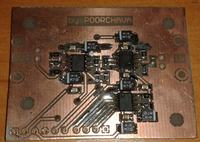jayachar88
Member level 3
Hi,
Context of the question is my current location, i.e. Bangalore - India. I know that there are lot of folks in other countries who have semi-professional (or professional grade) lab / bench at home, but I can ill afford that luxury here, both due to cost and availability.
So wondering if there are other folks here, from India, who work/worked on projects involving SMD components ? Would love to hear about their experience. What tools they use, where they purchased those tools, at what cost ? Where do you source your SMD components (in small quantities, esply) ? How do you do soldering ? etc.
cheers,
jay
Context of the question is my current location, i.e. Bangalore - India. I know that there are lot of folks in other countries who have semi-professional (or professional grade) lab / bench at home, but I can ill afford that luxury here, both due to cost and availability.
So wondering if there are other folks here, from India, who work/worked on projects involving SMD components ? Would love to hear about their experience. What tools they use, where they purchased those tools, at what cost ? Where do you source your SMD components (in small quantities, esply) ? How do you do soldering ? etc.
cheers,
jay
